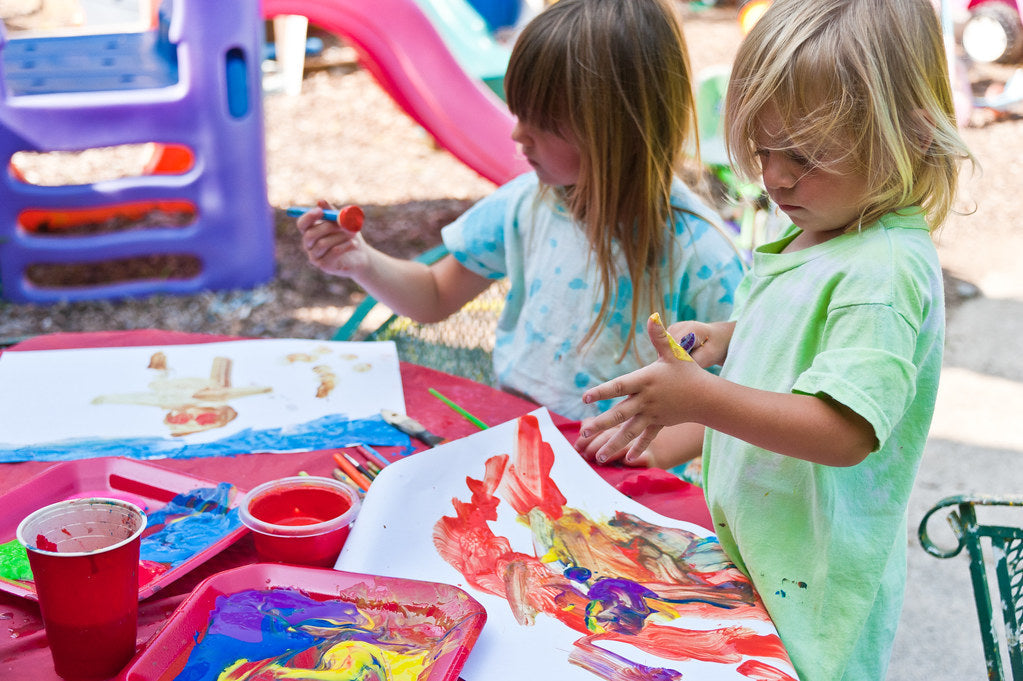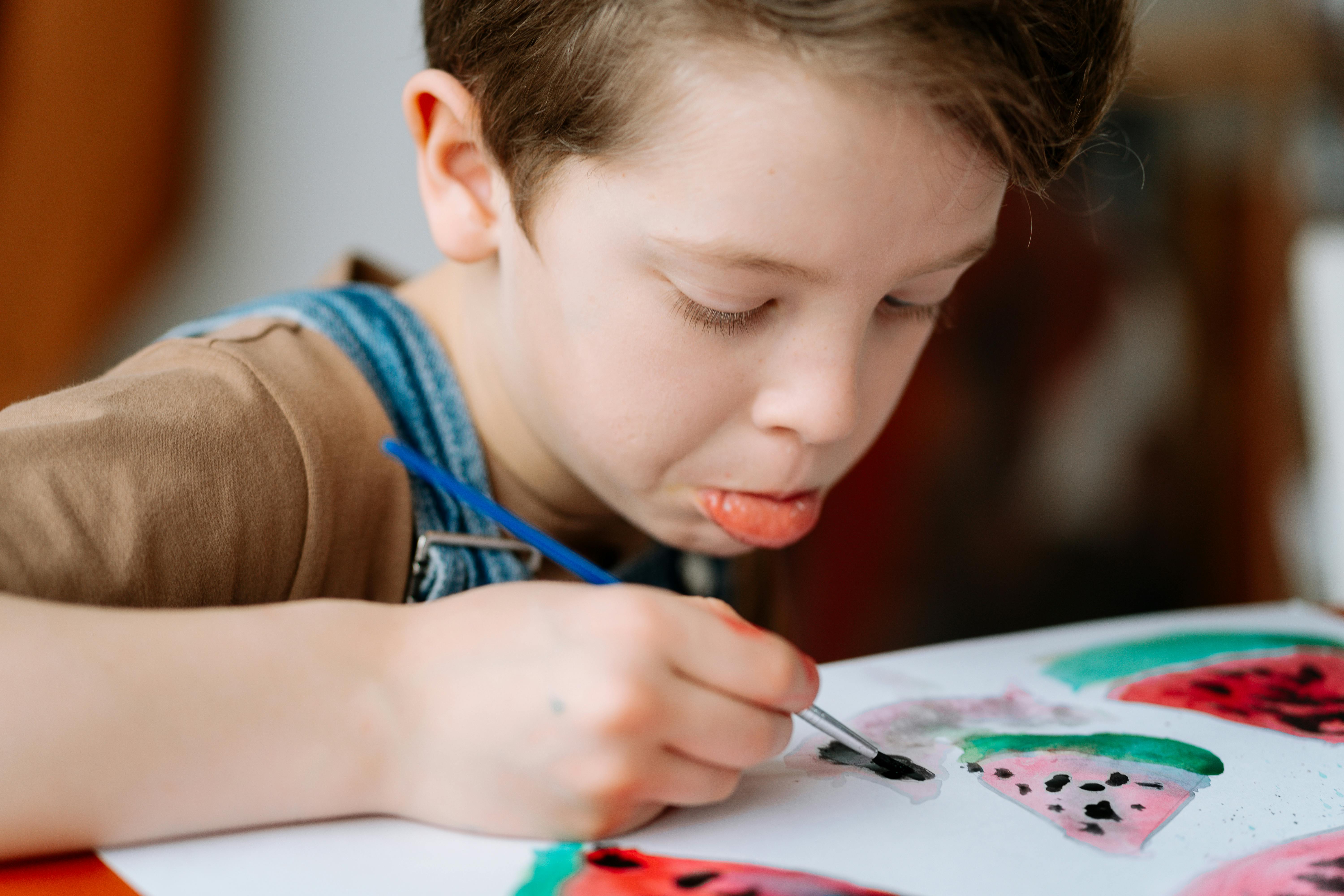
Art Activities to Do With Kids Who Are Sad, Scared, Worried, or Angry
June 15, 2022
By Beth Herrild
With so many scary things happening in the world, it’s no wonder that many of our kids are struggling with feelings of fear, sadness, and anxiety. Fortunately, art, like reading, is a meaning-making activity. It can help kids process some of their feelings and begin to make some sense out of them. There a number of art activities to help kids deal with emotions.
Researchers believe that humans can experience at least 27 basic emotions. However, Brene Brown and her colleagues surveyed over seven thousand people and found that the average number of emotions people could actually identify was three: happy, sad, and angry. And these were adults. Most kids don’t have the words to name and talk about all of their feelings. Art shows us that the limits of our language do not define the limits of our awareness. In other words, art helps children express what they may not otherwise be able to say.
The toughest part of feeling strong emotions as a child is that you believe you’re going to feel that way forever. They don’t yet have the life experience to know that most emotions eventually pass; and you can get flooded. And frankly, there’s a lot going on in the world that triggers some pretty big emotions in many of us.
When children are stuck in strong emotions, they are likely in their amygdala, or reptilian brain. The amygdala is part of the limbic system that mediates many aspects of emotion, particularly fear and threatening stimuli. But scientists now believe it also mediates positive emotions. When something happens or we get flooded with emotions we can be “hijacked” into our amygdala. The term “amygdala hijacking” was first used by psychologist Daniel Goleman in his 1995 book, Emotional Intelligence: Why It Can Matter More Than IQ. He used it to refer to an immediate and intense emotional reaction that’s out of proportion to the situation. Art is not the only way to get out of our amygdala, but it is one great tactic.
Disclaimer: I am not a therapist. I’m an artist and a mom. These activities and this article are not in any way intended to take the place of professional help. If your child has suffered trauma or is experiencing sustained sadness, anger, fear, or anxiety, seek help from a trained therapist. Below are some different art activities to help kids deal with emotions. These activities can assist them in focusing their attention and feeling calmer. You may also enjoy doing these. Adults can benefit from using art to help regulate emotions. Remember, you have to put on your own oxygen mask first before you can help others.
Because you know your child best, I have broken down these activities into three different categories so that you can decide what type of activity will work best for your child.
Tactile activities
Tactile activities, such as just playing with clay (mushing it, pounding it, or rolling it) or finger painting are great for younger children who cannot put words to their feelings.
• Clay: Our favorite clay is Creative Paperclay because it is soft, supple, totally non-toxic, and air dries. But, because it is an air dry clay, it will dry out. Break off a piece to use and immediately put the rest in a zip type baggie and seal it. If you intend to play with the clay for more than a few minutes, you can put the chunk you’ve been playing with back in the baggie and get out a fresh chunk. If the clay ever gets kind of dry feeling you can spray it with a tiny amount of water before sealing it in the baggie. Also, Silly Putty can be fun. It can also be a good stress buster to lay it on comics from the newspaper and then stretch and pull them into funny faces. Silly Putty is also a great thing to take on trips because it’s not messy at all.
• Finger painting: Our favorite paint for finger painting is water-soluble or water mixable oil paint. Water-soluble oils are oil paints that do not require the use of toxic chemicals for cleanup. They clean up with soap and water. You can use them on canvas boards, Masonite, or heavy paper. Just be sure to avoid any pigments that are toxic like cadmium, cobalt, and lead white. Some art supply manufacturers have eliminated most of the toxic pigments, but better to be cautious. If you purchase online from a reputable source, any toxic pigments should be labeled with a warning. The colors that are not safe for finger painting can be used with a brush, you just don’t want your kids to put them directly on their skin. If they are decent quality, they should be buttery and smooth to the touch and be very satisfying tactilely to use as finger paints! If, however, your child is tactilely defensive, take a look at Tips For Doing Art with Your Neuro-Divergent Kiddo.
Repetitive Activities
Repetitive activities are a good way to get kids to focus their attention and calm down. They help regulate emotions. Here are three different repetitive activities you can do:
• Coloring: Whether in a coloring book or using free coloring pages you can download from the Internet, you can find subject matter that matches the situation. For instance, a super hero image might keep your child in an agitated state whereas an image from nature might be more calming. Again, you know your child best.
•Painting lines or repetitive shapes: You can use paint and a brush (watercolor, acrylic, or tempera). Markers that have a brush tip are also good tools for this as long as you show your child how to use the brush tip gently.

•Zen Drawing: This is a type of drawing usually done with just a black marker or pen. It involves breaking up your paper into small sections and creating a different repetitive pattern in each section. The patterns can be extremely simple. The process is calming and the results are usually very satisfying. See a quick video of a heart Zen Drawing. Check out how Zen Drawing helped my family in this blog post. If you want to do something a little more challenging or your child is older, try creating mandalas with Zen Drawing.
Creating your emotions

Monster Drawing Project for Kids
There are many ways children can express their emotions in their art. Here are some art activities to help kids deal with emotions:
•Emotion Lines & Colors: Ask kids what colors feel happy, sad, worried, angry, or scared. Then ask them what types of lines feel like those emotions. If your child is feeling angry, he may say black and jagged lines. You can encourage him to draw or paint black (and maybe other dark colors) jagged lines over and over. Then ask him what colors and lines feel peaceful and to draw or paint blue or green (or whatever he said) in the shapes he said.
•Create their worry monster. Show your child some basic ways to draw, or paint a monster and then encourage him to create his own worry monster. Watch a quick video snippet of a monster project we did to get some ideas. After he has drawn it, he can rip up the paper or paint a giant red or black X or the monster! Two picture books that we recommend to introduce this exercise are: Harry and theTerrible Whatzit by Dick Gackenbach, and The Night the Scary Beasties Popped Out of My Head by David Kamish.
•Map of Your Heart: Another cognitive activity to name emotions and work through feelings is to map the heart. Give your child a piece of paper with an outline of a heart and encourage her to divide it into sections for each emotion she can name with the biggest sections representing the strongest emotions. You can use a simple heart shape or an anatomical heart shape. Encourage your child to color and illustrate her emotions. Younger children may not be able to do this and it may be difficult even for older children if they are too flooded with emotion. It may help to brainstorm all of the emotions she’s feeling first and ask her which ones are taking up the most room in her heart and which ones are getting squeezed into small spaces in her heart.

•Peaceful Place: Encourage your child to draw or paint a place where she feels peaceful. Many art therapists shy away from using the word safe because we, as adults, can’t totally guarantee that our kids are safe. The language is up to you as the parent since you know your child best. You may choose to use the word safe, or just the words peaceful, happy, calm… You may need to brainstorm what that place might look like/feel like. Have your child close her eyes and imagine. Once your child has finished the drawing or painting, she can hang it up where she can look at it when sad or scared feelings arise.
•Inside & Outside Masks: Purchase some inexpensive Paper Mache masks and encourage your child to decorate the outside with paint, markers, and/or collage (gluing images and words on) to represent the self your child shows to the world. Then, he can decorate the inside to depict the self not shown to most of the world – inner thoughts, feelings, and traits. This includes feelings your child may keep bottled up inside or doesn’t feel safe expressing to most people.
With all of these activities, be careful not to say things like “Oh, that’s so pretty or what is that?” Try to ask your child, “Can you tell me about your art?” And listen quietly and then ask some further open-ended questions. The more your child begins to articulate what she was trying to convey, the more emotionally intelligent she will become. Hopefully she’ll get to a point where she pulls out her favorite art supplies and begins creating whenever she feels sad, anxious, scared, angry, or happy!
*Product links above are Amazon affiliate links. We receive a very very small commission if you purchase through them, which we hope you will if you purchase products. This does not affect your price in any way!

